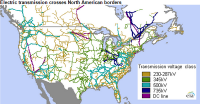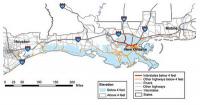-
U.K. bolsters flood defenses
In 1953, more than 300 people died in the United Kingdom alone when heavy storms swept a high spring tide over sea defenses and across coastal towns in north-east England and Scotland. Today floods still make headlines but our ability to limit their effects has come a long way. Flooding costs the United Kingdom £2.2 billion a year in defenses and repairs, and annual spending must keep growing just to maintain present defenses. That is a massive investment, but history — and recent history at that — shows that the risk of flooding should not be underestimated.
-
-
Developing nuclear cladding to withstand Fukushima-like meltdown conditions
Like much of the rest of the world, thousands of scientists and engineers watched in March 2011 as Japan’s Fukushima Daiichi nuclear reactors exploded. The fuel’s cladding, a zirconium alloy used to contain the fuel and radioactive fission products, reacted with boiling coolant water to form hydrogen gas, which then exploded, resulting in the biggest nuclear power-related disaster since Chernobyl. Challenged by this event, two research teams have made progress in developing fuel claddings that are capable of withstanding the high temperatures resulting from a Loss of Coolant Accident (LOCA), like that at Fukushima.
-
-
2013 attack on Metcalf, California power grid substation committed by “an insider”: DHS
A senior DHS official last Wednesday revealed that a 2013 sniper attack on a Metcalf, California energy grid substation – which the top U.S. electrical utility regulator has called “the most significant incident of domestic terrorism involving the grid that has ever occurred” — may have been committed by someone on the inside. The attackers fired more than 100 rounds of .30-caliber rifle ammunition into the radiators of seventeen electricity transformers, which caused the radiators to leak thousands of gallons of oil, which made electronics overheat and shut down.
-
-
Philippines coastal areas go underwater due to sea level rise
More than 167,000 hectares of Philippines coastland — about 0.6 percent of the country’s total area — are projected to go underwater in, especially in low-lying island communities, according to research by the University of the Philippines. Low-lying countries with an abundance of coastlines are at significant risk from rising sea levels resulting from global warming. According to data by the World Meteorological Organization, the water levels around the Philippines are rising at a rate almost three times the global average due partly to the influence of the trade winds pushing ocean currents. On average, sea levels around the world rise 3.1 centimeters every ten years. Water levels in the Philippines are projected to rise between 7.6 and 10.2 centimeters each decade.
-
-
Managing urban stormwater runoff better
As meteorologists monitor the El Nino condition currently gaining strength in the Pacific Ocean, Californians look with hope to the much-needed rain and snow it could yield. But if Californians are going to make the most of the precipitation, they need to put a LID on it. LIDs, or low-impact development technologies, mimic pre-urban stream functions. Examples are green roofs that absorb and evapotranspire rainfall; rainwater tanks attached to homes and other buildings; and permeable pavement for roads, driveways and parking lots. Rainwater could even be used in the home for toilet flushing and laundry.
-
-
Grid Security Conference focuses on information sharing among stakeholders
More than 300 industry and federal partners are participating in the North American Electric Reliability Corporation’s (NERC) annual grid security conference, or GridSecCon, in Philadelphia, which opened on Wednesday and ends today. The conference is focusing on key cyber and physical security issues and training for enhancing the security and resiliency of the North American bulk power system. Topics of panel discussions include upgrades to NERC’s E-ISAC, cyber and physical security technology options, the transition to Version 5 of NERC’s critical infrastructure protection standards; and expectations for NERC’s third grid security exercise, GridEx III, which takes place 18-19 November.
-
-
Will the Supreme Court kill the smart grid?
On 30 April, Tesla’s Elon Musk took the stage in California to introduce the company’s Powerwall battery energy storage system, which he hopes will revolutionize the dormant market for household and utility-scale batteries. A few days later, the Supreme Court announced that it would hear a case during its fall term that could very well determine whether Tesla’s technology gamble succeeds or fails. At issue is an obscure federal policy known in the dry language of the electricity business as “Order 745,” which a lower court vacated last year. Order 745 allowed electricity customers to be paid for reducing electricity usage from the grid — a practice known as “demand response.” It also stipulated that demand response customers would be paid the market price for not using the grid — like the power industry’s version of paying farmers not to grow corn. This case, ultimately, is far more significant than getting paid for not using electricity. It’s about who gets to set the rules of the road for emerging technology in the electricity sector — the states or the federal government — and whether the United States will be able to modernize its energy policy the same way that it would like to modernize its power grid.
-
-
Improve cybersecurity in energy delivery
Cyber networks support many important functions within energy delivery systems, from sending data between a smart meter and utility to controlling oil or gas flow in a pipeline. However, they are vulnerable to disturbances. According to the ICS-CERT Monitor, a publication of the U.S. Department of Homeland Security, a third of the 245 reported cyber incidents in industrial control systems that happened in 2014 occurred in the energy sector. The U.S. Department of Energy (DoE) initiative awards $28.1million to a consortium of eleven universities and research organizations, with the goal of improving computer/communication networks for energy delivery systems like power grids and pipelines.
-
-
Protecting the U.S. power grid from cyberattacks

In the first half of Fiscal Year 2015, the Industrial Control Systems Cyber Emergency Response Team (ICS-CERT), part of the Department of Homeland Security, responded to 108 cyber incidents impacting critical infrastructure in the United States. As in previous years, the energy sector led all others with the most reported incidents. Researchers from Florida International University’s (FIU) College of Engineering and Computing have teamed up with four other universities and a utility company to help safeguard the nation’s power utilities from cyberattacks.
-
-
U Warwick, U.K. National Grid expand £1.5 million partnership
Last week the University of Warwick and the U.K. National Grid have signed a Memorandum of Understanding (MoU) to extend the strategic alliance they have operated for last two years. To date that alliance has engaged in over £1.5 million worth of research and student scholarships in areas such as electricity transmission asset management, gas transmission, micro-tunneling, and cyber security.
-
-
Sea level rise dooms Miami, New Orleans

Say goodbye to Miami and New Orleans. No matter what we do to curb global warming, these and other beloved U.S. cities will sink below rising seas, according to a new study. “In our analysis, a lot of cities have futures that depend on our carbon choices but some appear to be already lost,” says one of the study’s authors. “And it is hard to imagine how we could defend Miami in the long run.” An online tool shows which U.S. cities may face “lock-in dates beyond which the cumulative effects of carbon emissions likely commit them to long-term sea-level rise that could submerge land under more than half of the city’s population,” said the study.
-
-
Instant water heater offers energy, cost savings
Traditional water heaters take time to reach preferred temperatures, thus wasting water and energy. A new instant hot water solution, developed through the EU-funded RAPIDHEAT project, successfully optimized heating and control technologies to develop a lightweight low thermal mass heater that provides full temperature output within two seconds of switch-on.
-
-
Cost-effective, non-polluting enhanced geothermal systems

Tapping the natural heat of the earth may be more cost-effective and clean thanks to a research into a new area of geothermal energy, called enhanced geothermal systems. These systems are designed to enable power production in areas where conventional geothermal techniques do not work. Unlike typical geothermal systems, which rely on porous rock, enhanced geothermal systems have much greater potential to tap the energy of geothermal hot spots in areas of otherwise impermeable bedrock. The potential could be especially high in the western United States, including New Mexico.
-
-
NSF awards $74.5 million to 257 interdisciplinary cybersecurity research projects
The NSF the other day announced the awarding $74.5 million in research grants through the NSF Secure and Trustworthy Cyberspace (SaTC) program. In total, the SaTC investments include a portfolio of 257 new projects to researchers in thirty-seven states. The largest, multi-institutional awards include research better to understand and offer reliability to new forms of digital currency known as cryptocurrencies, which use encryption for security; invent new technology to broadly scan large swaths of the Internet and automate the detection and patching of vulnerabilities; and establish the “science of censorship resistance” by developing accurate models of the capabilities of censors.
-
-
Cyber vulnerability of civil nuclear facilities underestimated
The risk of a serious cyberattack on civil nuclear infrastructure is growing, as facilities become ever more reliant on digital systems and make increasing use of commercial off-the-shelf software, according to a new report. The report finds that the trend to digitization, when combined with a lack of executive-level awareness of the risks involved, means that nuclear plant personnel may not realize the full extent of their cyber vulnerability and are thus inadequately prepared to deal with potential attacks.
-
More headlines
The long view
Helping Strengthen America’s Critical Infrastructure
Everyday life depends on a robust infrastructure network that provides access to running water, communications technology and electricity, among other basic necessities. The experts who keep our national infrastructure secure and resilient also need a strong network to share their knowledge and train the next generation of professionals capable of solving complex infrastructure challenges.
AI and the Future of the U.S. Electric Grid
Despite its age, the U.S. electric grid remains one of the great workhorses of modern life. Whether it can maintain that performance over the next few years may determine how well the U.S. competes in an AI-driven world.
Using Liquid Air for Grid-Scale Energy Storage
New research finds liquid air energy storage could be the lowest-cost option for ensuring a continuous power supply on a future grid dominated by carbon-free but intermittent sources of electricity.
Enhanced Geothermal Systems: A Promising Source of Round-the-Clock Energy
With its capacity to provide 24/7 power, many are warming up to the prospect of geothermal energy. Scientists are currently working to advance human-made reservoirs in Earth’s deep subsurface to stimulate the activity that exists within natural geothermal systems.
Experts Discuss Geothermal Potential
Geothermal energy harnesses the heat from within Earth—the term comes from the Greek words geo (earth) and therme (heat). It is an energy source that has the potential to power all our energy needs for billions of years.
